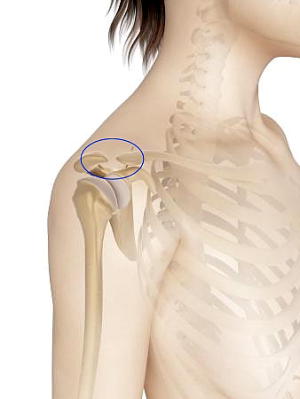This article by
Daniel Lopez, D.O. is re-printed
from the Internet
-
A “knotted” spasm in the trapezius muscles is a common pain
complaint. You can tell if you have one, simply by squeezing the fleshy
area between your neck and your shoulder. If this area is sensitive,
tight, and painful, then you have “knots” in your trapezius.
People
often seek out massages, injections, medications, and more, to get rid of
these painful knots. We like to blame it on stress, backpacks, and all
kinds of other reasons for this pain. Unfortunately, few people ever
offer solutions that actually work because they do not understand why
the knots develop in the first place.
Massages and injections
may not work because the reason for the spasm in the muscle is not
addressed. For example, the
trapezius is becoming tight and “knotted”
for a reason. The reason may be, because it is responding to a slight
dysfunction at the acromioclavicular joint (AC joint), which is a place
where the muscle attaches and a joint the trapezius moves.
The problem
is that the AC joint does not actively hurt, so it may not be in our
awareness that there is a problem there and it may not be in the
awareness of the massage therapist, physician, practitioner, or person
giving you an injection. Therefore, the trapezius spasm gets
 massaged,
squeezed, injected, and lots of other therapeutic interventions, but the
spasm is still there. Why? Because the trapezius muscle is contracting
to protect the dysfunction at the AC joint.
massaged,
squeezed, injected, and lots of other therapeutic interventions, but the
spasm is still there. Why? Because the trapezius muscle is contracting
to protect the dysfunction at the AC joint.
Unless the AC joint problem
gets resolved, the trapezius will continue to spasm. The solution,
therefore, is not to work on the tight trapezius “knot,” but commonly
may be to work on the AC joint problem the trapezius is responding to. The
trapezius attaches on the clavicle and shoulder blade. The clavicle
articulates with shoulder blade at a structure called
the “acromion.”
Together they make the “acromioclavicular” joint.
Although not the ball
and socket joint of the shoulder, the AC joint is part of the shoulder
and can have an effect on shoulder range of motion. A contraction of the
upper or lower trapezius can produce motion at the AC joint. Therefore,
even a slight problem at this joint can produce a reflexive contraction
to protect the joint from becoming more problematic. The end result is a
spasm or “knot” in the trapezius. Think about what may be happening when
people wear backpacks that are too heavy. The straps will put a lot of
pressure on these joints and cause them to stop working properly. Then
the trapezius muscles will contract and a permanent knot will be there
unless the AC joint dysfunctions are resolved. Too often, specialists
are looking in the wrong area.
Check out this video -
Grab onto your trapezius between your neck and shoulder joint
and give it a squeeze. Tenderness here may be indicative of an AC joint
dysfunction. Also, it gives you a starting point to know how things have
changed afterwards.
Find your collar bone and trace it
 outward
until you feel the end of it. There may be a digit there or a bump. That
is your AC joint. Another way of finding it, is simply to on the top of
your shoulder and look for a bump.
outward
until you feel the end of it. There may be a digit there or a bump. That
is your AC joint. Another way of finding it, is simply to on the top of
your shoulder and look for a bump.
Grip your AC
joint with your thumb and index finger and slowly wiggle it back and
forth. You may notice that at first it is not tender, but as you do this
an underlying tenderness will show up. Do this until you feel that the
bump can move a little more freely.
Recheck your
trapezius and see if it feels different.
Do this once
a day until it stops feeling tender and is freely moveable. You should
notice your trapezius will likely feel less knotted and less sensitive.
Hopefully this will help you to understand why other treatment methods
have failed to produce results. It is important to ask why a muscle is
producing an active spasm or “knot” and dealing with the reason. The
other option is living with the pain that this unresolved issue
produces. Which sounds like the better option?